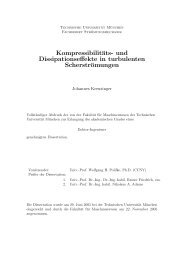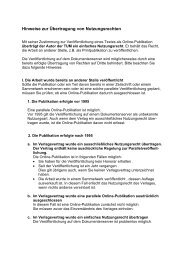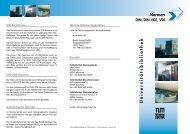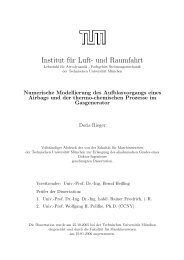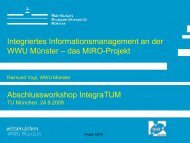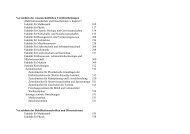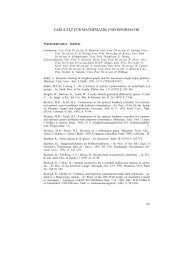LES of shock wave / turbulent boundary layer interaction
LES of shock wave / turbulent boundary layer interaction
LES of shock wave / turbulent boundary layer interaction
You also want an ePaper? Increase the reach of your titles
YUMPU automatically turns print PDFs into web optimized ePapers that Google loves.
Chapter 3<br />
Flat plate <strong>boundary</strong> <strong>layer</strong><br />
A well known problem in the simulation <strong>of</strong> <strong>turbulent</strong> <strong>boundary</strong> <strong>layer</strong>s<br />
is that realistic inflow data are needed. Recently Xu & Martin (2004)<br />
have reviewed different inflow generation techniques. Following them,<br />
the inflow generation techniques can be organized into three categories:<br />
1 spatially evolving <strong>boundary</strong> <strong>layer</strong> simulating the full transition process;<br />
2 using data from previous simulations (or data combined with those<br />
from experiment);<br />
3 various techniques using an instantaneous downstream flow field<br />
(streamwise periodic <strong>boundary</strong> conditions, extended temporal approach,<br />
rescaling and recycling method, etc.).<br />
A brief summary <strong>of</strong> available simulations can be found in appendix A.<br />
A DNS <strong>of</strong> a spatially evolving <strong>turbulent</strong> supersonic flat-plate <strong>boundary</strong><br />
<strong>layer</strong> is conducted by Rai et al. (1995). A developed <strong>turbulent</strong> <strong>boundary</strong><br />
<strong>layer</strong> with a momentum thickness <strong>of</strong> Re θ ≈ 4500 was obtained by the<br />
simulation <strong>of</strong> laminar-<strong>turbulent</strong> transition initiated by a blowing/suction<br />
strip. This case is close to an experiment by Shutts et al. (case 55010501<br />
in Fernholz & Finley (1977)) with Re θ ≈ 6000 and M ∞ = 2.25. Later<br />
Gatski & Erlebacher (2002) and Pirozzoli et al. (2004) repeated this DNS<br />
on a finer grid. Their results showed that both the near-wall asymptotic<br />
behavior and the log-law exhibit similarities with the incompressible case<br />
when the van-Driest velocity transformation is applied. Similarly, the<br />
Reynolds stresses also are independent <strong>of</strong> Mach number when scaled with<br />
the mean density ratio as suggested by Morkovin (1962). The results also<br />
showed that the total temperature fluctuations were not negligible. <strong>LES</strong><br />
<strong>of</strong> this case was performed by Spyropoulos & Blaisdell (1998) using a<br />
dynamic Smagorinsky model and by Rizzetta & Visbal (2004), using<br />
Smagorinsky, dynamic Smagorinsky and MI<strong>LES</strong> approaches.<br />
Guarini et al. (2000) employed a ”slow growth” assumption to simulate<br />
a <strong>turbulent</strong> <strong>boundary</strong> <strong>layer</strong> at Re θ = 1577. It is assumed that the<br />
<strong>boundary</strong> <strong>layer</strong> grows slowly in the streamwise direction so that the turbulence<br />
can be treated as approximately homogeneous in this direction.



